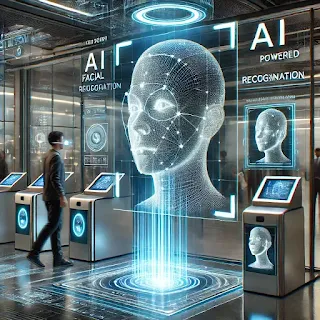Understanding Facial Recognition Technology: Benefits and Challenges
- Get link
- X
- Other Apps
Understanding Facial Recognition Technology: Benefits and Challenges
Table of Contents:
- Introduction
- How Facial Recognition Works
- Key Benefits of Facial Recognition
- Major Concerns and Risks
- Real-World Applications
- Ethical and Privacy Issues
- Future Innovations and Regulations
- Conclusion
1. Introduction
Facial recognition technology (FRT) has rapidly become an integral part of modern life, used in smartphones, security systems, and even public surveillance. This AI-driven biometric identification method has revolutionized convenience and security, but it also raises significant privacy and ethical concerns. In this article, we will explore how facial recognition works, its benefits, risks, applications, and the debates surrounding its use.
2. How Facial Recognition Works
Facial recognition relies on artificial intelligence (AI) and deep learning algorithms to analyze and identify faces. Here’s how it works:
Step-by-Step Process:
- Image Capture: A camera captures an image or video of a face.
- Facial Detection: The system detects and isolates the face from the background.
- Feature Extraction: Unique facial features (such as the distance between the eyes or jawline shape) are measured and converted into a digital template.
- Database Comparison: The system compares the extracted features with a stored database.
- Identification or Verification: The system either identifies the person or verifies their identity based on stored data.
 |
| Facial Recognition Process Illustration |
For a more visual explanation, check out this video:
3. Key Benefits of Facial Recognition
1. Enhanced Security
Facial recognition is widely used for security purposes, from unlocking phones to border control at airports. Law enforcement agencies use it to identify criminals, while businesses deploy it for access control.
2. Convenience and Speed
FRT enables contactless authentication, allowing users to unlock devices, authorize payments, and check into flights quickly. Apple’s Face ID and similar technologies have made authentication seamless.
3. Crime Prevention and Public Safety
Governments and law enforcement agencies use FRT to track suspects, identify missing persons, and enhance public safety in crowded areas.
4. Improved Customer Experience
Retailers use FRT to personalize shopping experiences. Banks utilize it for fraud prevention and secure customer authentication.
5. Healthcare Applications
Hospitals use facial recognition to identify patients, streamline administrative processes, and improve healthcare delivery.
4. Major Concerns and Risks
While FRT has many benefits, it also comes with notable risks:
1. Privacy Violations
Facial recognition can be used for mass surveillance without individuals’ consent, raising concerns about privacy and data security.
2. Accuracy Issues and Bias
Studies show that FRT algorithms can be biased, leading to higher error rates for certain demographic groups, particularly people of color and women. These biases can result in false identifications and discrimination.
3. Data Security Risks
Storing facial recognition data poses a cybersecurity risk. Hackers could potentially gain access to biometric data, leading to identity theft.
4. Ethical Concerns
The use of facial recognition in public spaces without explicit consent raises ethical questions about surveillance, autonomy, and individual freedoms.
5. Real-World Applications
Facial recognition is used across multiple industries:
- Law Enforcement: Used to identify suspects and solve crimes.
- Retail: Enhances security and provides personalized marketing.
- Banking: Enables secure authentication for financial transactions.
- Healthcare: Assists in patient identification and medical record management.
- Airports & Travel: Facilitates fast security clearance and boarding.
6. Ethical and Privacy Issues
1. Lack of Regulation
Many countries lack comprehensive regulations on facial recognition, leaving room for misuse.
2. Consent and Transparency
People often don’t know when and how their facial data is being collected. Organizations should implement transparent policies and obtain explicit consent.
3. Data Protection Laws
Stronger data protection laws, such as the GDPR in Europe, help regulate the use of biometric data. The U.S. still has fragmented laws regarding facial recognition.
 |
| Future of Facial Recognition Technology |
7. Future Innovations and Regulations
1. Advancements in AI and Accuracy
AI researchers are working on improving the accuracy and fairness of facial recognition algorithms to reduce biases.
2. Integration with Other Biometrics
Combining FRT with other biometric authentication methods, such as fingerprint scanning and voice recognition, could enhance security and reliability.
3. Stricter Regulations and Policies
Governments worldwide are expected to introduce stricter policies governing the use of FRT to prevent misuse while ensuring security and efficiency.
 |
| Facial Recognition Privacy Concerns |
8. Conclusion
Facial recognition technology is transforming security, business, and daily life, offering convenience and enhanced protection. However, it also presents privacy risks, ethical dilemmas, and potential biases that must be addressed through careful regulation and responsible implementation. As technology evolves, balancing innovation with personal freedoms will be crucial in ensuring a fair and secure future.
Sources and References
- Get link
- X
- Other Apps




Comments
Post a Comment